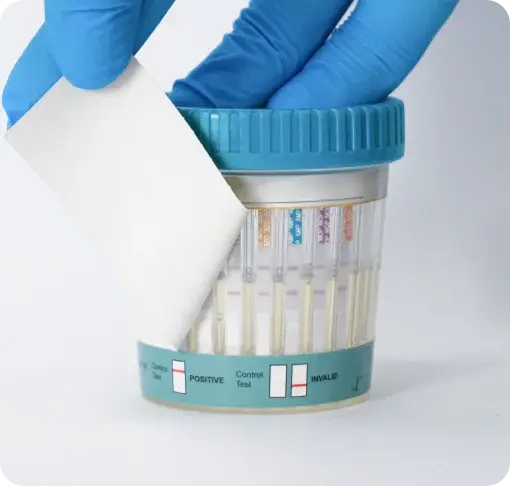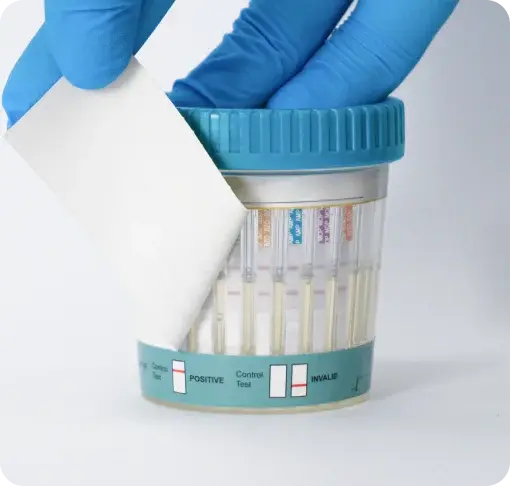A Complete Guide for Employers and Healthcare Providers
Codeine is a prescription opioid used to treat mild to moderate pain and coughing. While it has important medical uses, codeine is a controlled substance in the UK and poses a risk of misuse and dependency. As a result, healthcare professionals and employers must be aware of how to detect and interpret codeine use in clinical and workplace drug testing.
In this blog, we explore how codeine is detected, how long it remains in the system, what it shows up as, and what to consider when reviewing drug test results in healthcare and occupational settings.
What Is Codeine?
Codeine is an opioid analgesic and antitussive commonly found in prescription medications, often combined with paracetamol (co-codamol) or other substances. While safe when used as prescribed, it can be habit-forming and cause sedation, impaired coordination, and respiratory depression.
Street names include:
- Schoolboy
- Cody
- Lean (when mixed with soda—popularised as "purple drank")
- T-three (for Tylenol 3, a codeine/paracetamol combo)
Will Codeine Show Up on a Drug Test?
Yes. Codeine is an opioid and will appear on standard opioid drug tests. However, what is detected in the test may vary depending on metabolism and the type of test used.
When ingested, codeine is partially converted into morphine in the liver. As a result, both codeine and morphine may be present in drug test results. It’s also possible for hydrocodone to appear in some cases due to further metabolic processes.
Codeine and its metabolites are commonly detected in multi-panel drug screens, including 5-, 6-, 9-, 12-, 14-, and 16-panel tests.
Which Drug Tests Detect Codeine?
In healthcare and workplace environments, the most common tests are point-of-care (POC) urine and saliva tests:
Codeine Urine Test
- Detection Window: Typically 1–3 days after last use
- Use Case: Routine screening, return-to-duty, pre-employment
- Cut-Off Levels: Around 300 ng/mL (can vary by lab or policy)
- Advantages: High sensitivity, reliable, widely accepted
Codeine Saliva Test
- Detection Window: Up to 24–36 hours after use
- Use Case: On-site/POCT screening, incident-related testing
Advantages: Quick turnaround, non-invasive, minimal training required
How Long Does Codeine Stay in the System?
| Test Type | Window Detection |
| Urine | 1-3 Days |
| Saliva | 1-3 Days |
Factors that influence detection:
- Dosage and frequency of use
- Metabolism and body composition
- Concurrent use of other medications
- Liver function and hydration levels
Can a False Positive Happen?
Yes, though uncommon, false positives for codeine can occur in rapid tests due to the presence of other opioids or certain medications. Potential causes include:
- Use of poppy seed-containing foods (can result in morphine/codeine detection)
- Certain cold and flu medications
- Sample contamination or handling errors
Laboratory confirmation testing via GC-MS or LC-MS is strongly recommended following any non-negative result to eliminate the risk of misinterpretation.
What Does Codeine Look Like on a Drug Test Result?
At AttoSure, our drug testing kits feature separate strips for opioid detection. Codeine typically shows under OPI or MOP (morphine) depending on the panel configuration. A positive result indicates the presence of codeine and/or its metabolites in the tested sample.
If the codeine (OPI/MOP) strip shows a non-negative, the individual may not necessarily be impaired at the time, but it does confirm recent use. In clinical settings, this result may warrant further medical review. In the workplace, the usual next step is to send the sample for confirmatory laboratory testing.
Important note for employers: A non-negative result should not be used as grounds for dismissal without a full confirmatory report. Employers should follow their workplace drug and alcohol policy and ensure fair treatment.
Why Employers and Clinicians Test for Codeine
As a central nervous system depressant, codeine can impair alertness, slow reaction times, and increase the risk of accidents—especially in safety-sensitive roles. Testing helps organisations:
- Maintain workplace safety
- Support staff wellbeing and recovery
- Comply with legal and industry standards
Industries that often require opioid testing include:
- Healthcare and emergency services
- Transport and logistics
- Manufacturing and engineering
- Education and public service
You can also test your knowledge with our expert-designed quizzes tailored for workplace and healthcare settings. We pride ourselves on delivering first-class educational content, created by our team of scientific experts. Browse our selection of quizzes below.
Final Thoughts
Codeine is a legally prescribed drug with a high potential for misuse. Testing for codeine in the workplace and clinical settings is crucial for managing risks, supporting recovery, and ensuring compliance with occupational safety standards.
At AttoSure, we offer quick, accurate, and confidential codeine testing solutions tailored to healthcare providers and businesses. Our trusted laboratory partners provide reliable confirmation testing and professional result interpretation—so you can make informed decisions with confidence.
Contact Us


